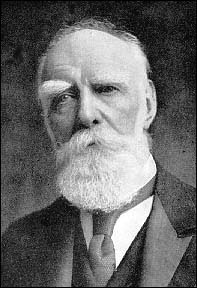|
 1820 - Donald Alexander Smith was born on 6 Aug 1820, in a small cottage next to the old
Castle Bridge over the Mosset Burn (A burn is a creek.) in Forres, Scotland, United Kingdom. After attending school at
Anderson's Institute in Forres (now Anderson's Primary School) he worked in the Town Clerk's Office until 1838. His
Uncle, John Stuart, a Canadian pioneer and fur trader who worked for the Hudson's Bay Company, was a great influence in
his life and it was he who persuaded the young Lord Strathcona to go to Canada to take up employment as a clerk for the
Hudson's Bay Company at Hamilton Inlet, Labrador. 1820 - Donald Alexander Smith was born on 6 Aug 1820, in a small cottage next to the old
Castle Bridge over the Mosset Burn (A burn is a creek.) in Forres, Scotland, United Kingdom. After attending school at
Anderson's Institute in Forres (now Anderson's Primary School) he worked in the Town Clerk's Office until 1838. His
Uncle, John Stuart, a Canadian pioneer and fur trader who worked for the Hudson's Bay Company, was a great influence in
his life and it was he who persuaded the young Lord Strathcona to go to Canada to take up employment as a clerk for the
Hudson's Bay Company at Hamilton Inlet, Labrador.
1869 - As a "Special Commissioner" appointed by the Canadian Government, Lord Strathcona was
despatched to the Red River area to quell the uprising of Louis Riel and his provisional government rebels. This had
been caused by the transfer of rights to "Rupert's Land" for £300,000 by the Hudson's Bay Company to
Canada. Lord Strathcona was imprisoned by Riel at Fort Garry until February 1870 but it was not until 1872 that Lord
Strathcona was officially thanked for helping to avert bloodshed in the area.
1870 - As a member of the North-West Council he passed the "Smith Act" prohibiting intoxicating
liquors because of Indian problems.
1871 - The year when the Manitoba Act was passed bringing the province into the Dominion, Lord Strathcona was
elected member for Selkirk, Manitoba, in the Dominion House of Commons. The same year he was also appointed Chief
Commissioner for Hudson's Bay Company affairs in the North West.
1874 - Lord Strathcona was determined to complete the bankrupt "St. Paul & Pacific Company"
railway to the Canadian border, and he hoped the Dominion Government would pay for its completion to Winnipeg.
1877 - He persuaded his cousin, George Stephen, later to become Lord Mount Stephen, to join his railway
group.
1879 - The "St. Paul, Minneapolis & Manitoba Railway Company" was incorporated with George
Stephen as President and Lord Strathcona as Principal Director.
1880 - A syndicate was formed with the aim of completing a Canadian transcontinental railway. On 10 Dec 1880
the Canadian Pacific Railway Company's contract was laid before the House of Commons, with George Stephen as one of the
eight signatories. Lord Strathcona was not one, at his own request, but was still deeply involved.
Editor's Note: Probably "laying low" after his vote against Macdonald in the House.
1881 - Building commenced on 2 May 1881 at an average of 2.6 miles per day.
1885 - The railway was completed at 09:22 on 7 Nov 1885 when Lord Strathcona drove the Last Spike at
Craigellachie, British Columbia.
1886 - Queen Victoria bestowed Donald Smith with a Knighthood of the Order of St. Michael and St. George.
1887 - Lord Strathcona returned to politics as well as continuing his charitable and beneficial works. He
lobbied for the protection of the bison, and at one point owned the last herd. In the same year he and his cousin Lord
Mount Stephen set aside $1,000,000 to erect a free hospital in Montreal commemorating Queen Victoria's Jubilee. Situated
on the flanks of Mount Royal, the Royal Victoria Hospital was completed in 1893, and both men endowed it with a further
$800,000.
1897 - Donald Alexander Smith was created a peer of the realm in June, taking the title "Baron Strathcona
and Mount Royal of Glencoe, Argyllshire, and Montreal, Canada." (Lord Strathcona).
1890 - Being concerned about Britain's efforts in the Boer War, he created the "Strathcona Horse", a
mobile force of 600 Canadian rough riders led by Colonel Steele. Lord Strathcona never forgot his home in Forres.
Amongst his many good deeds was a contribution of some £8,238 towards the Leanchoil Hospital in Forres which
admitted its first patient on 24 Apr 1892 and was named after his mother's birthplace.
1900 - He was given the Freedom of the Royal Burgh of Forres.
1902 - He laid the foundation stone of the Forres United Free Church and also the stone of the new St.
Lawrence Church.
1914 - 21 Jan 1914 he died at 28 Grosvenor Square in London and was interred in Highgate Cemetery.
Chris Bridgeford - Scotland, United Kingdom.

|